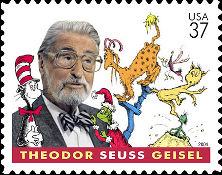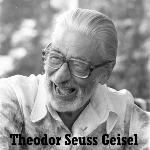
 Backyard to the Universe
Backyard to the Universe


DR. SEUSS AND UNITARIAN UNIVERSALISTS
INTRODUCTION
Please share this Introduction with anyone who is facilitating a session. Thank you.

Welcome to the vision and revision of session plans to accompany stories by Dr. Seuss (Theodore Geisel). Some of these session plans were written around 1991 when I was the Director of Religious Education in Augusta, Maine. These have been revised, and sessions for other stories have been added. Inspiration came from some older curricula, and other curricula have been developed since, including some build on these session plans. These sessions are also on my web site at www.hzmre.com. Speaking of the web, find out how congregations have used Dr. Seuss material by doing a search, such as through www.Google.com and ask for "Dr. Seuss and Unitarian Universalists." This brings up the question:
Why use the stories of Dr. Seuss in Unitarian Universalist congregations?
These stories are fun and engaging. But even more important, they are based on life situations and experiences and give us a way to reflect, to talk about things that are part of our lives.
- we all sleep,
- we all get lost,
- we all are afraid sometimes,
- we all meet people who are on -- and sometimes in -- our way,
- we all like adventure in various ways,
- we all struggle with what is right and what is not.

Stories have been used in Unitarian Universalist religious education material for generations. The stories of Dr. Seuss are wonderful resources. A key to using the stories is to have a dialog. This means that each participant is able to express thoughts about the story or the reflection questions, and there is no need to come to a common view or to convince anyone that a particular view is correct. In a dialog, each participant contributes, listens to others, and hears new perspectives. Details of the story do not matter: how the participant relates to the story does.
Some stories may raise uncomfortable situations. For example, my daughter, now in her 30's, still remembers the fear of getting lost that she felt in I Had Trouble Getting to Solla Sollew. I personally react to 500 Hats of Bartholomew Cubbins because of the idea of being chased, although my son heard that story as a great adventure to see if another hat would appear. The pictures and the rhythm of the words of the stories may mask the deeper meanings.
Therefore, an important focus of this dialog is to have the group listen to each of the participants if and as they tell stories of being in uncomfortable situations, without giving advice or "you could have" or "you should have." However, the group can also raise some concrete suggestions about what can be done if the situation arises again. The stories may deal with a range of situations from teasing to severe abuse, from adventure to fear. If there is need to process any of the situations beyond the group setting, like a participant appearing to be in danger, let him/her know that you would like to talk with him/her further, and then follow your congregation's procedure, if there is one in place. If there is no procedure, talk with the Director of Religious Education and minister and parents, as needed.
The story summaries, but NOT the stories themselves, are included in the curriculum. The books can be obtained from libraries, book stores (actual and on-line), yard sales and flea markets. Hopefully, the Overview Chart will provide information to assist in deciding when to use the various stories. There is no specific order or recommendation. Some guidelines might include:
A story is of interest or a 'favorite' of the adult who is facilitating the session -- even inviting people to select the story(ies) that they would like to share with the group.
There may be a desire to group stories by themes, or to spread themes throughout the year.
Some stories will be more available than others.
The length of a story may influence where a story can be used: a 10 minute story is a bit long for "Time With Children" in a Sunday service!
Dr. Seuss's A B C might gives an opportunity for introductions of the to each other participants (using the alphabet as initials) and to the church environment (the alphabet around the church or site). Too Many Daves is also an opportunity to make nametags.
Please note the selection of terms, which are part of the movement toward more Relational Religious Education.
"Session" rather than "lesson," with a focus on the time spent together;
"Participant" rather than "child," as the adults in the group are also part of the experience;
"Facilitator" of "leader" rather than "teacher," as much of the teaching and learning comes from the group itself;
"Group" rather than "class," as the participants may be various configurations of ages..
SESSION PLAN FORMAT
Setting the Stage: Introductory information includes:
- Ages: The suggested ages are usually taken from "Dr. Seuss Books in Print" (www.seuss.org/seuss/seuss.books.html), and follow the title. These ages are only suggested, and many of the stories are 'ageless'. For example, Oh, The Places You'll Go! is noted for 5-8 years, but is a great gift for high school and college graduates.
- Story Synopsis. This very brief statement sets the stage for the story but does not give details or resolution.
- Time estimate: And the estimated length of time it takes to read the story follows the Story. Synposis. This may be a factor in determining how the stories are used.
- Affirmation(s). Affirmation/Principle that could be applied to the story is suggested (see the end of the Introduction). Participants themselves may suggest which Affirmation(s) apply.
- Theme(s). The theme(s) that seem to be apparent in the story is (are) given, understanding that participants may identify other themes. The suggested theme is a resource in planning.
- Preparation. Read the story several days before using it. Let the story be in "the back of your mind". Note ways in which you connect with the story. Read the story aloud several times to get the flow and rhythm. Additional considerations are noted in the session plans.
- Needed. Things that will be needed for the session includes the location of the story (book by itself or in another book). A general list of supplies throughout the sessions includes:
Session Plan
Opening: There is no standard opening for the sessions, but a commonly used one is:
We meet here as Unitarian Universalists.
This is the church of the open mind. [point to head, or hand by face, palms facing out]
This is the church of the helping hands. [hands out in front, palms up]
This is the church of the loving heart. [hands together across chest]
Check-in. The suggestions here follow a pattern for Relational Religious Education. Even if check-in is part of another activity, such as Children's Worship, please still take time to welcome each person by name. This is a time for paying attention to who is present, as well as acknowledging that someone is missing, and if there is a known reason, such as illness. It is suggested that there be an empty chair for someone who is not present, and to indicate that others are welcome to join the group. (A stuffed animal that a participant has brought or that is the group mascot may sit in the chair.)
Story: Usually, telling rather than reading a story is encouraged. Dr. Seuss is an exception, because the illustrations and use of language are such a dynamic part of the total story. Some of the stories are available on tapes or video cassettes, which can supplement the lesson plan. However, the value of reading the stories "live" cannot be underestimated. Reading is at a slower pace and allows for interaction as the story progresses.
Exploring. This includes questions for dialog and there may be suggested activities. These are a beginning, and the facilitator is welcome to add other ideas, which will come from "living with" the story as part of preparation.
Closing. Closings are usually suggested, but a standard closing from the group can also be used.
Group Review. Please allow time for input from the group about what went well and suggestions for using this story again. It might be helpful to make notations that stay with the session plan for consideration in the future use.
Affirmations/Principles
The American Unitarian Association and the Universalist Church of America formed the Unitarian Universalist Association (UUA) in 1961. Unitarian Universalists recognize that beliefs evolve and change. The Principles and Purposes are in the Bylaws of the UUA (Article II). The process for developing and changing them includes intense discussion in local congregations and at General Assembly over several years. The Principles and Purposes (or "the Principles"), adopted in 1985, are:
• Ideals toward which we work, rather than requirements for membership;
• Guidelines for religious and ethical living;
• Sources of inspiration for religious education, worship, and social action.
There are two components of the Principles and Purposes are the Affirmations and the Living Tradition Sources. The affirmations are presented first in the Principles. Perhaps a difference between our affirmations and creeds or covenants of other religious traditions is that these affirmations form the common bond among us as guidelines for living, rather than a theological statements of belief.
The second part of the Principles is the sources from which the affirmations have developed. It is the sources that establish the diversity of our religious tradition. While both Unitarian and Universalists have roots in Judeo-Christian heritage, Unitarian Universalism is a tradition, which draws on universal elements in the world's religions. The sources are evident in the stories that we tell, the rituals that we use, the hymns that we sing, and in religious education. The focus in this curriculum is on the Affirmations/Principles. These are given here in the wording from the Unitarian Universalist Association Bylaws, followed by a version for younger children from the UU Alphabet, 1999, by Rev. Helen Zidowecki, adapted.
We, the member congregations of the Unitarian Universalist Association, covenant to affirm and promote:
We remember that:
The inherent worth and dignity of every person.
Everyone is important.
Justice, equity and compassion in human relation.
We are fair and kind to each other.
Acceptance of one another and encouragement to spiritual growth in our congregations.
Church is a place where we learn together.
A free and responsible search for truth and meaning.
We are always learning for ourselves.
The rights of conscience and the use of the democratic process within our congregations and in Society at large.
We have a say about things that are important to us.
The goal of world community with peace, liberty and justice for all.
We help make the world better for everyone.
Respect for the interdependent web of all existence of which we are a part.
We help take care of our world.
© Rev. Helen Zidowecki